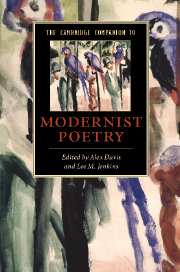4 - Gender, sexuality and the modernist poem
from Part I: - Contexts
Published online by Cambridge University Press: 28 November 2007
Summary
Debates concerning the topics of gender and sexuality were ubiquitous in the West around the turn of the century. Active women's movements throughout Europe, the British Isles and the United States brought women's legal rights and social positioning to political consciousness, and the study of sexuality fuelled the new fields of psychology and sociology, as well as being a favourite topic of the popular press. This period coined the words 'homosexuality' (first used in the USA in 1892) and 'feminism' (around 1910), and there was enormous interest in both defining and blurring boundaries between 'masculine' and 'feminine' behaviours. In the late nineteenth century, normative categories had primarily to do with gendered, not sexual, behaviour and experience - whether one manifested appropriate characteristics for a man or woman. Heterosexuality was assumed, but masculinity or femininity were the salient markers for the cultural norm, and initially also for the new sexually directed vocabulary. Sexual object choice became linked to categories of sexuality only later in the century and after a period of definitional murkiness, when individuals perceived as manifesting the general mental characteristics of the opposite sex were considered to be sexually 'inverted', 'homosexual' or belonging to a 'third-sex'. Moreover, this mental state was judged according to appearance (clothes, haircut), professional choices and manner. Hence, during these decades, there was opportunity for a fluidity of personal performance or definition among categories of sexual being, even as there was increasing pressure for stricter normative and more sexually focused categorisation. The scholarship on these evolving gender and sexual normative definitions is now vast, and no aspect of modernist poetry remains untouched by them - from an understanding of individual poets' anxieties and desires in relation to their changing times, to the readings of particular poems, to analysis of the new aesthetic as it was practised and theorised by this generation of writers.
- Type
- Chapter
- Information
- The Cambridge Companion to Modernist Poetry , pp. 68 - 84Publisher: Cambridge University PressPrint publication year: 2007
- 2
- Cited by



